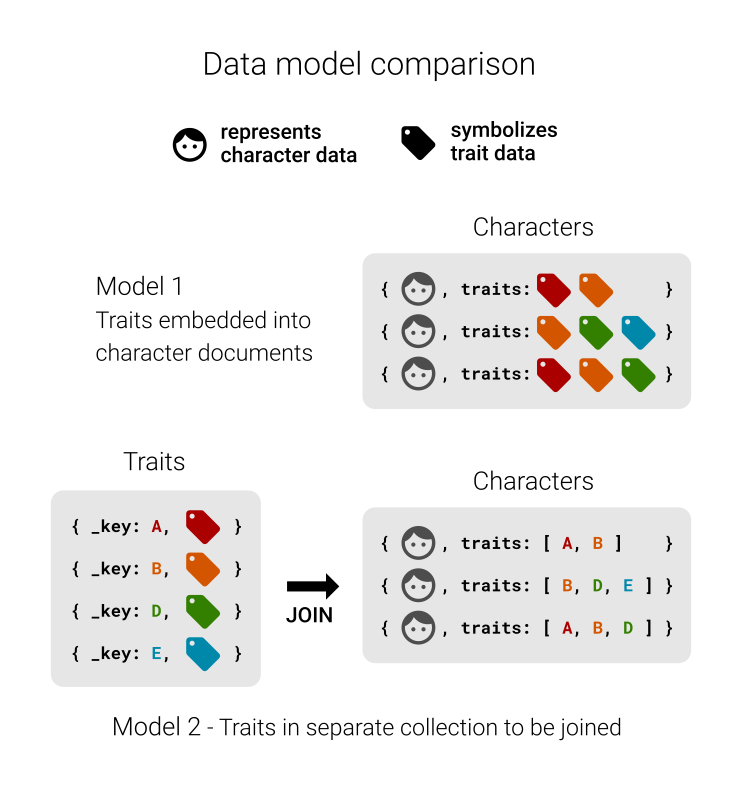Joining together
References to other documents
The character data we imported has an attribute traits for each character, which is an array of strings. It does not store character features directly however:
{
"name": "Ned",
"surname": "Stark",
"alive": false,
"age": 41,
"traits": ["A","H","C","N","P"]
}
It is rather a list of letters without an apparent meaning. The idea here is that traits is supposed to store documents keys of another collection, which we can use to resolve the letters to labels such as "strong". The benefit of using another collection for the actual traits is, that we can easily query for all existing traits later on and store labels in multiple languages for instance in a central place. If we would embed traits directly...
{
"name": "Ned",
"surname": "Stark",
"alive": false,
"age": 41,
"traits": [
{
"de": "stark",
"en": "strong"
},
{
"de": "einflussreich",
"en": "powerful"
},
{
"de": "loyal",
"en": "loyal"
},
{
"de": "rational",
"en": "rational"
},
{
"de": "mutig",
"en": "brave"
}
]
}
... it becomes really hard to maintain traits. If you were to rename or translate one of them, you would need to find all other character documents with the same trait and perform the changes there too. If we only refer to a trait in another collection, it is as easy as updating a single document.

Importing traits
Below you find the traits data. Follow the pattern shown in Create documents to import it:
- Create a document collection Traits
- Assign the data to a variable in AQL,
LET data = [ ... ] - Use a
FORloop to iterate over each array element of the data INSERTthe elementINTO Traits

[
{ "_key": "A", "en": "strong", "de": "stark" },
{ "_key": "B", "en": "polite", "de": "freundlich" },
{ "_key": "C", "en": "loyal", "de": "loyal" },
{ "_key": "D", "en": "beautiful", "de": "schön" },
{ "_key": "E", "en": "sneaky", "de": "hinterlistig" },
{ "_key": "F", "en": "experienced", "de": "erfahren" },
{ "_key": "G", "en": "corrupt", "de": "korrupt" },
{ "_key": "H", "en": "powerful", "de": "einflussreich" },
{ "_key": "I", "en": "naive", "de": "naiv" },
{ "_key": "J", "en": "unmarried", "de": "unverheiratet" },
{ "_key": "K", "en": "skillful", "de": "geschickt" },
{ "_key": "L", "en": "young", "de": "jung" },
{ "_key": "M", "en": "smart", "de": "klug" },
{ "_key": "N", "en": "rational", "de": "rational" },
{ "_key": "O", "en": "ruthless", "de": "skrupellos" },
{ "_key": "P", "en": "brave", "de": "mutig" },
{ "_key": "Q", "en": "mighty", "de": "mächtig" },
{ "_key": "R", "en": "weak", "de": "schwach" }
]
Resolving traits
Let's start simple by returning only the traits attribute of each character:
FOR c IN Characters
RETURN c.traits
[
{ "traits": ["A","H","C","N","P"] },
{ "traits": ["D","H","C"] },
...
]
Also see the Fundamentals of Objects / Documents about attribute access.
We can use the traits array together with the DOCUMENT() function to use
the elements as document keys and look up them up in the Traits collection:
FOR c IN Characters
RETURN DOCUMENT("Traits", c.traits)
[
[
{
"_key": "A",
"_id": "Traits/A",
"_rev": "_V5oRUS2---",
"en": "strong",
"de": "stark"
},
{
"_key": "H",
"_id": "Traits/H",
"_rev": "_V5oRUS6--E",
"en": "powerful",
"de": "einflussreich"
},
{
"_key": "C",
"_id": "Traits/C",
"_rev": "_V5oRUS6--_",
"en": "loyal",
"de": "loyal"
},
{
"_key": "N",
"_id": "Traits/N",
"_rev": "_V5oRUT---D",
"en": "rational",
"de": "rational"
},
{
"_key": "P",
"_id": "Traits/P",
"_rev": "_V5oRUTC---",
"en": "brave",
"de": "mutig"
}
],
[
{
"_key": "D",
"_id": "Traits/D",
"_rev": "_V5oRUS6--A",
"en": "beautiful",
"de": "schön"
},
{
"_key": "H",
"_id": "Traits/H",
"_rev": "_V5oRUS6--E",
"en": "powerful",
"de": "einflussreich"
},
{
"_key": "C",
"_id": "Traits/C",
"_rev": "_V5oRUS6--_",
"en": "loyal",
"de": "loyal"
}
],
...
]
This is a bit too much information, so let's only return English labels using the array expansion notation:
FOR c IN Characters
RETURN DOCUMENT("Traits", c.traits)[*].en
[
[
"strong",
"powerful",
"loyal",
"rational",
"brave"
],
[
"beautiful",
"powerful",
"loyal"
],
...
]
Merging characters and traits
Great, we resolved the letters to meaningful traits! But we also need to know to which character they belong. Thus, we need to merge both the character document and the data from trait document:
FOR c IN Characters
RETURN MERGE(c, { traits: DOCUMENT("Traits", c.traits)[*].en } )
[
{
"_id": "Characters/2861650",
"_key": "2861650",
"_rev": "_V1bzsXa---",
"age": 41,
"alive": false,
"name": "Ned",
"surname": "Stark",
"traits": [
"strong",
"powerful",
"loyal",
"rational",
"brave"
]
},
{
"_id": "Characters/2861653",
"_key": "2861653",
"_rev": "_V1bzsXa--B",
"age": 40,
"alive": false,
"name": "Catelyn",
"surname": "Stark",
"traits": [
"beautiful",
"powerful",
"loyal"
]
},
...
]
The MERGE() functions merges objects together. Because we used an object
{ traits: ... } which has the same attribute name traits as the original
character attribute, the latter is overwritten by the merge.